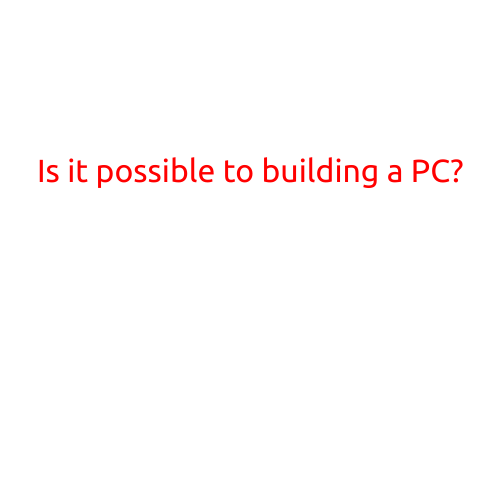
Is it possible to build a PC?
In today’s world of technology, building a personal computer (PC) has become a popular hobby and a great way to save money while still having a customized computer tailored to your specific needs. But for those who are new to the world of computer building, the thought of putting together a PC from scratch can be daunting.
In this article, we’ll answer the question: “Is it possible to build a PC?” and provide a comprehensive guide on how to do it, step by step.
What is required to build a PC?
Before we dive into the process, it’s essential to understand what’s needed to build a PC. Here are the basic components required:
- CPU (Central Processing Unit): This is the brain of your computer, responsible for executing instructions. Examples include Intel Core i5 or i7, AMD Ryzen 5 or 7.
- Motherboard: This is the main circuit board of your computer, connecting all the components together. Make sure it’s compatible with your CPU.
- RAM (Memory): This temporary storage allows your computer to multitask and run multiple applications simultaneously. Aim for at least 8GB.
- Storage: This is where your computer stores its operating system, programs, and data. Options include hard disk drives (HDD), solid-state drives (SSD), or a combination of both.
- Power Supply: This component provides power to all the components in your PC. Choose a PSU with a wattage that matches your system requirements.
- Graphics Card: This is responsible for rendering images on your screen. You can opt for an integrated graphics card or a separate graphics card.
- Case: This is the outer casing of your PC, housing all the components. Look for a case that fits your components and has good airflow.
- Cooling System: This keeps your components at a safe temperature. Options include air cooling or liquid cooling.
- Operating System: This is the software that manages your computer’s hardware and provides a user interface. Popular options include Windows or Linux.
Step-by-Step Guide to Building a PC
Now that we’ve covered the necessary components, let’s go through the step-by-step process of building a PC:
Step 1: Unpack Your Components Carefully unpack each component, taking note of any cables or screws that may be included.
Step 2: Assemble Your CPU and Motherboard Apply a thin layer of thermal paste to the CPU, then secure it to the motherboard using the provided socket. Make sure to align the notches on the CPU with the pins on the motherboard.
Step 3: Install RAM Locate the RAM slots on your motherboard, and gently push the RAM modules into place until they click. Make sure to follow the specific RAM installation procedure for your motherboard.
Step 4: Add Storage and Power Supply Install your storage device(s) and connect them to your motherboard. Secure your power supply to the case, connecting it to the motherboard and other components.
Step 5: Install Graphics Card Insert your graphics card into the PCIe slot on your motherboard, making sure it’s securely seated.
Step 6: Assemble Your Case Attach the front and top panels of your case, securing them with screws. Install your CPU cooler and any other internal components, such as fans or a hard drive cage.
Step 7: Connect Cables Connect the power cables from your power supply to your components, making sure to follow the specific cable labeling and color-coding. Connect any data cables, such as SATA or HDMI.
Step 8: Install Operating System Insert your installation media (USB or CD/DVD) and follow the installation prompts to install your operating system.
Conclusion
Building a PC is a rewarding experience that requires minimal technical expertise. By following the step-by-step guide provided, you can successfully assemble your own computer and enjoy the satisfaction of knowing you built it with your own hands.
Remember to take your time, double-check your connections, and research any specific requirements for your components or motherboard. With these tips, you’ll be well on your way to creating a customized PC that suits your needs and budget.
Tips and Tricks
- Ground yourself by touching a metal object or wearing an anti-static strap to prevent damaging your components.
- Use a anti-static wrist strap and mat to prevent electrical shock.
- Make sure your components are compatible with each other and your motherboard.
- Follow the manual or online instructions for specific component installation procedures.
- Test your PC thoroughly before installing your operating system.
By following these guidelines and tips, you’ll be able to build a PC that meets your needs and exceeds your expectations. Happy building!





